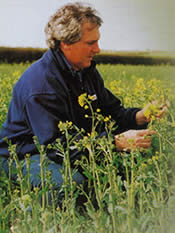April 1, 2003
One-pass Rape establishment options can produce high yields with low establishment costs - a definite win/win situation, says agronomist.
Well established crops that have achieved target/satisfactory populations – this is the conclusion of Cambridgeshire agronomist Nick Myers after walking a number of oil seed rape stands in East Anglia recently.
A variety of different crop establishment systems were employed - from direct drilling, minimum tillage, and broadcasting behind the combine header to Till –Seeding using seeders mounted on subsoilers, discs and cultivators.
 However the costs of establishment will vary greatly with the different methods used, he warns.
However the costs of establishment will vary greatly with the different methods used, he warns.
The previous crop's straw (winter wheat in all cases) was removed in all the fields except those direct drilled. “The direct drills coped well with chopped straw,” says Nick. But he stresses the importance of even chopping and distribution of the chopped straw and chaff - otherwise the rape plants have to emerge through dense layers of straw and can be quite etiolated.
“The effect of 'lock up' of nitrogen is also exacerbated,” he adds, “while slugs also are more severe where large amounts of straw occur.”
From observation of fields with sowing dates ranging from mid August to mid/late Sept, Nick’s experience is that seeding behind the combine header and direct drill systems seem to prefer early establishment i.e. mid/late August rather than early Sept.
“All systems with reduced tillage but especially seeding behind the combine header and direct drilling benefit from autumn applied nitrogen. In these latter systems mineralisation of soil N is especially limited,” he says.
“Sowing direct behind the combine header and direct drilling have shown poorer establishment in the wheelings left by the combines. Where straw is baled the baler has usually followed the combine further packing the soil. This effect has been noticeable in the last two years when the weather and consequently the soil have been wet during harvesting of the crop prior to oilseed rape.
“Due to the poor establishment in the wheelings, one farmer direct drilling his oilseed rape subsoiled all the tramlines from the previous crop.”
The same problem has also been found with the broadcast system followed by a shallow cultivator, says Nick. Headland areas and areas of heavy traffic have not established quite as well as the main field area. The depth of cultivation (around 25mm) is not enough to remove surface compaction and hence some form of deeper soil movement is advisable in these areas.
Till-Seeded crops established with the seeder mounted on a subsoiler have not shown any of these effects, Nick points out.
“ The depth of cultivation, usually around 30-40 cm, takes out all soil compaction. Fears of uneven depth of seed distribution seem unfounded. Plant populations were (visually) within the normal ranges from seed rates of 4 -5 kg/ha.
“The crops I observed were followed with a double press pulled behind the subsoiler (modified Shakerator) and then rolled to conserve soil moisture. Despite the very dry weather in September following sowing in late August, all the crops grew and established well. The consolidation of the soil also helped with preventing slug problems.”
Rooting of the “Subsoiler mounted seeder crops” was vigorous, straight and showed no signs of compaction or waterlogging, he adds. Plants from the reduced cultivation systems were often 'fanfy' or horizontal where there was any tightness or compaction in the soil.
With the reduced cultivation systems there was some evidence of surface 'ponding' where drainage was slow in the wet conditions last autumn.
“The main criticism of the Subsoiler approach was its relatively slow work rate with drilling rates of two hectares/ hour being recorded,” says Nick. “However, this is dependant on the size of machine used and you have to remember it is a one-pass system
“The min till system had established very well from a low seed rate of 3 kg/ha. However, it had taken 4 passes of cultivator and combi-drill to produce.
“Overall,” Nick concludes, “ all methods on similar soil types (silty clay - silty clay loam textures) produced satisfactory plant populations. Each has its own cost structure and ultimately the true test of success will be the Net Margin.
“There is a possibility that the one pass systems may not produce the top yields but savings in overhead (labour and machinery) costs may more than compensate for lower yields. Also it is totally feasible that the one-pass options can produce high yields with low establishment costs - a definite win/win situation.”